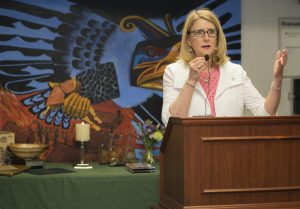An inside look at the technologies protecting our nation’s forests
From paper goods to lumber and wildlife habitat to recreation, our forests provide value in countless ways. However, forest management is a complex science. It requires advanced technology, collaboration, and an eye toward sustainability.

Forest management has advanced rapidly since the days of lumber mills and surveyors. The sector is exploding with technological advancements that are improving data collection, enhancing efficiency, and helping to maintain the delicate forest ecosystems on which we rely.
One technology being implemented throughout the forestry industry is LIDAR, a remote sensing method that uses light to measure distances. Forest management services can now use LIDAR to map forest canopy surfaces, tree structures, and underlying forest topography.
Kathy Abusow, president and CEO of the Sustainable Forestry Initiative, shared her insights on the technology’s applications: “LIDAR helps people see how things are being managed, which is really important so they see this emerging transparency in the supply chain. The technology is increasingly being used to help us understand biodiversity needs as well because you can’t send people everywhere all the time. LIDAR is just an amazing tool for a forest manager and planner.”
The forestry sector is also using DNA testing to chart biodiversity within forest ecosystems. For example, DNA sampling from vernal pools tells researchers how many species exist in a certain location and helps them make better decisions for the health of the forest. Abusow explains, “We have to understand where we can harvest trees because some of these vernal pools are really rich in biodiversity. It could be turtles at risk, or frogs, or different species that need special consideration.”
She continued, “We now can take water from the pool and have DNA testing to say, ‘From this vernal pool there are all sorts of species in there. So, let’s not harvest in that area. Let’s go over here, where there isn’t that type of impact.’ The technology is just so cool in terms of how we can manage things now.”

Drones are also playing an active part in forest maintenance as unmanned aerial surveillance systems (UAS) become more affordable and accessible. Chief of the USDA Forest Service Vicki Christiansen spoke about the life-saving value of UAS: “In our wildland fire response, having good data about the active fires… is really important. Putting people in harm’s way to gather that intelligence is not something we want to expose people to. So, using UAS is escalating our abilities in wildland fire response and in many other natural resource applications.”
Vegetation management is another area benefiting from innovation. Christiansen explains, “We need to thin these forests through timber and hazardous fuel sales. Now, we can put up virtual boundaries.” She continued, “We can write the prescriptions [for thinnings] electronically on handheld devices… we can do that all digitally and we don’t have to mark with paint.”
Between digital thinning prescriptions, UAS fire intelligence, DNA sampling, and LIDAR, the forest sector is embracing advanced technologies with open arms. But forest management requires more than managing trees, it requires managing people. Coordinating 25,000 full-time employees and 10,000 seasonal hires is no simple feat.
Christiansen knows firsthand the challenges of effective communication among so many workers. “It is a challenge to stay real-time coordinated and communicate… We’ve come a long way since the start of the Forest Service when we had to string telephone lines to just have one conversation, maybe once a week. Now, we take full use of our technology.”
In the United States, there are over 766 million acres of national-, private-, state-, and tribal-owned forest lands. Managing employees to maintain and oversee that much acreage requires significant coordination. Christiansen said of the challenge: “We are a networked organization. We can’t operate just as one unit at a time, so it’s a real priority of mine, and at the Forest Service that we stay connected internally… It’s only together that we can leverage what is the conservation challenge of our time.”
At the core of forest management is conservation, a word that has taken on new significance in the era of climate change. “The forest sector as a whole needs to look at the health and resilience of our forests. We have multiple stressors… extended drought, a changing climate, and much longer fire seasons. Our scientists have studied this and we have at least a 78-day increase in fire seasons than we did just 15 years ago. We need to really look at our climate adaptation,” noted Christiansen.

The sector is working thoughtfully to mitigate the impacts of environmental stressors. Christiansen remarked on the Forest Service’s approach to climate adaptation: “We think about resiliency and how we can be adaptable… There’s really good science that indicates this risk, so we’re trying to anticipate ahead of time what treatments, even what kind of species we plant, that will help us maintain these forests.”
The Forest Service has instituted several programs to bring more money and fresh ideas into the sector. Their Wood Innovations Grants funding program, for example, encourages the creation and adoption of new technologies to reduce management costs, promote economic health, and improve forest health while supporting the long-term management of National Forest systems.
Another program, Project Learning Tree, aims to raise awareness among children of the importance of forest conservation and management. Abusow spoke about the program during our recent interview: “Project Learning Tree (PLT) is a program we are very proud of and want to grow. Anyone interested in supporting PLT can donate to our website, PLT.org. We will take all the support we can get to help grow the next generation of future forest and conservation leaders.”
Ultimately, the mission of the U.S. Forest Service is one that every person should support. Its goal is to maintain the health, diversity, and productivity of the nation’s forests and grasslands for the benefit of current and future generations. It’s a message of conservation, and surprisingly, one that will require ever-evolving technological innovation to ensure its success. ■











